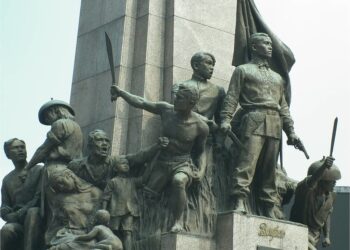
Anna is author of a book titled, “Ocho Ocho: My Childhood In War-torn Asia” published in 2012, which talks about her childhood memories, the years the Bucher family spent in China and the Philippines.
In her prefatory message, she notes that her then five-year-old granddaughter Mattea asked her to share a story about her childhood and she didn’t know where to begin until this decision to write a book came along. She writes it in a form of letters to her eight grandchildren.
Her biography chronicles with razor-sharp clarity childhood circumstances. She remembers vividly places in pre-war Manila, the people they were with, the games Filipino children play including her favorite “ocho ocho,” the fruit-bearing trees and their Tagalog names, the names of their cook, lavandera, yaya and their playmates in the mission complex in Malate, Manila.
They lived next door to the Ellinwood Bible School and on page 34 of the book, it is no wonder how Anna has remembered their Manila address all these years: they would recite their address as if it were a game. They lived at 607 Tennessee and Wright Streets, or in present day Manila, at the corner of General M. Malvar and Antonio Vasquez Streets.
Finding the book and the author is not by happenstance. I was gathering stories about war survivors and my readings led me to Professor Henry Bucher Jr., who was a young boy when the Bucher family lived in the Philippines. I exchanged emails with Professor Henry and wife Cat and he gifted me with a copy of his sister’s memoir. Not long after I am having a wonderful conversation with the author herself, about China, Manila and the internment camp in Los Banos, Laguna in what is now the University of the Philippines-Los Banos.
The Buchers led by Presbyterian missionaries Henry Hale Bucher and Louise Scott Bucher were earlier living in Nodoa, on the island of Hainan, southern China, as part of the Presbyterian mission evangelizing in the village of the Loi ethnic Chinese.
Of the three siblings born in China, Anna, the eldest, had recollection of how their father would be away for days doing missionary work among the Loi people. She also remembers how their kitchen is detached from the main house. From the coastal village of Haikow, they later moved to Nodoa until their furlough. Even before they returned home for a year-long break, war was already imminent. The Marco Polo Bridge incident had snowballed into the Second Sino-Japanese War. When they returned to China, they had not lived long in the new mission station in Beijing when they were forced to relocate to the Philippines.
In the Philippines, they temporarily stayed in Baguio City before they moved to Manila, near the Ellinwood Bible School. Although their stay in Baguio City was short-lived, Anna fondly recalls the visit she made to the Igorot village, how they would toboggan down the slopes blanketed with pine tree needles.
They find a more permanent settlement in Manila not long after, near Union High School, in the Presbyterian Mission Complex. From pages 9 through 38 of her biography, the author adeptly narrates and captures her fondest memories, the games she played, the Filipinos who worked for them, her lifelong friend Mab, the rampant thievery in war-torn Manila, her father’s vegetable garden, how her Filipina friend Pilar knows how to cook rice–the traditional way, among other recollections of people, places and events.
“When we were living in Manila the Chinese businessmen made sure that we had enough money to live in a reasonable manner,” Anna shares during our conversation. In her book, she also underscores the generosity of Filipinos.
“Filipinos were equally generous and loyal to the best of their abilities.”
It was also in Manila that the family welcomed their fourth child, George Scott.
By July 7, 1944 they received orders to pack and they would be relocated to the University of Santo Tomas in Manila; however, they were reassigned to Los Banos camp where they stayed until the paratroopers liberated them in 1945.
At the Los Banos Camp, the Buchers were assigned to a 12’ x 20’ cubicle. “When we got to the camp, at first it was fine. One room–it was one long barracks. That was all right. To me as a kid it was no big deal. The worst part of course was towards the end when we had no food. It was getting kind of bad,” says Anna.
Anna recalls how they survived from the vegetables they could harvest from his father’s garden. As food became scarce, they ate fried banana skins and slugs. Her father suffered the worst. “He had a very bad beriberi. A great many people in the camp had beriberi especially the men. I do not know why.”
In Los Banos, there were two camps. “We knew a great many of the people in the upper camp but not very many in the lower camp at all. Even when they put the two camps together, it was like two small cities.”
When asked about the now famous Raid of Los Banos, how the combined U.S. Army paratroopers and Filipino guerrilla force successfully rescued more than 2,000 internees behind enemy lines, Anna remembers it full well.
On Feb. 23, 1945, they saw American planes flying low. Minutes later, the internees were asked to vacate their barracks by the American soldiers in full battle gear, which she describes in her book as “everyone looked like a Goliath to us.” She says they were told to leave the barracks at once. The rescue lasted about 20 minutes. “They had it beautifully organized.”
In the videos of the rescue mission, now posted on YouTube, the internees are seen fleeing and leaving behind their barracks engulfed in fire. Anna explains that the U.S. Army set the barracks on fire as they wanted to get the people to leave and they were having a hard time getting people out of there. They wanted to leave nothing to the Japanese who could utilize them.
That day is fraught with fright for a young girl. “You bet it was scary.” The children were the first ones to board the amtracs, the amphibious vehicles waiting at Laguna de Bay. “It was so scary when we were in the amphibious tanks, crossing Laguna de Bay and we were being shot at,” she recalls. As soon as they were dropped off on the other side, in Muntinlupa, the amtracs would come back for the others.
Anna and Mab have remained close after the war. She, however, wonders what ever happened to the Filipinos who worked for them in Manila. She knew that their cook, Leonarda, and her mother corresponded for a long time; however, they lost track of the others.
“We don’t know if they survived or not. We didn’t know their last names.”











